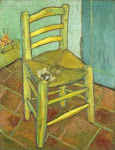
Visitors to MoMA's "Van Gogh and the Colors of the Night" will be able to see one of my personal top 3 van Gogh paintings, "The Starry Night over the Rhone," painted in Arles in late September 1888. The painting belongs to the Musee d'Orsay in Paris but travels quite a bit for various exhibitions.
A photograph cannot do this painting justice. There's such movement, such texture in the way the paint is built up on the surface of the canvas, that (as with most van Goghs) you want to reach out and touch it. I first saw this painting in person in 1996 at the Orsay, and it took my breath away. Every subsequent viewing, I've discovered something new. I love it so much I gave its creation a whole chapter in my novel!
In Arles, you can stand on the very spot where Vincent painted his picture, today marked with a poster. (I did this, of course!) The skyline looking downstream as Vincent saw it actually hasn't changed all that much. But Vincent took liberties with the sky: as Charles Whitney explained in his 1986 journal article "The Skies of Vincent van Gogh," the Big Dipper (or as Vincent referred to it in a letter to Theo, the Great Bear) is a constellation of the northern sky, whereas Vincent is facing to the southwest. Presumably he turned toward the north while working to observe the stars, then created this composite scene. But why? Prof. Whitney in his research learned that the southwestern sky in Arles at the time Vincent created his painting was not very exciting, with only a few stars; moreover, there was a full moon around that time, which would have been visible to the south. For whatever reason, Vincent opted not to paint the moon (which in other pictures, he likes) and instead chose the stars. The fact there was a full moon debunks a common myth: that Vincent painted outside in Arles with candles stuck in his hat (we see this in the film version of "Lust for Life," for example). He wouldn't have needed it.
As for the couple in the foreground, described by Vincent in a letter to Theo as "two colorful little figures of lovers": happy couples with linked arms were a motif in Vincent's work while in Paris and Arles. In some cases, as here, the man is shown with a yellow straw hat, and it is tempting to see the painted couples as Vincent's wishful thinking. (In my novel, I have some fun with the painted couples...)
Vincent was very proud of this picture and held it in higher esteem than the more famous Starry Night (painted in June 1889). It was even exhibited, together with the Getty "Irises," in the Salon des Independents in Paris in fall 1889. It did not sell, and we learn later that Theo and his bride Johanna hung the Starry Night over the Rhone in the salon of their Paris apartment.






3 comments:
Oh I absolutely love this painting!! It's in my top three too. I think it's the water. Or how he captured the exact mood of standing out under a starry sky. Something I can't quite capture in a photograph much to my frustration. Thanks for the post! I'll let you know when I go to the MoMA for the exhibit. I warned my husband that I need more than the one hour I got at the Turner exhibit at the Met. Sigh :)
Interesting read. Great blog by the way.
Hi Amanda:
Only an hour in an exhibition, that's just wrong! :-) Please do report back on the show when you visit. I'm bummed I'm not going myself.
Hi Balhatain: thank you and welcome!
Post a Comment